Roller Pigeons: Overview, History, And More
Watching their gravity-defying aerial acrobatics, it’s easy to see why roller pigeons have enthralled audiences for centuries. But their spectacular somersaulting is just one facet of their extensive repertoire.
Tracing their origins back over 400 years to the Middle East and Europe, roller pigeons have been meticulously bred for competitive performance and distinctive traits.
Today, over 500 breeds exist worldwide, prized for attributes ranging from the tumbling ability to elegant plumage.
Whether you’re an avid breeder or simply mesmerized by their midair pirouettes, this comprehensive guide will cover key facets of roller pigeons, from their origins and characteristics to care, breeding, and threats they face today.

Come discover what makes these charming avian marvels such a hit in the pigeon fancier community and beyond.
Roller Pigeon Profile Table
| Information | Details |
|---|---|
| Scientific Name | Columba livia domestica |
| Common Names | Birmingham Roller, Galatz Roller, Oriental Roller, Parlor Roller |
| Origin | Birmingham, England |
| Size | Small |
| Weight | Not specified in the search results |
| Lifespan | 10-15 years |
| Physical Features | Long wings, various colors (black, blue-grey, brown, white, and white and black) |
| Temperament | Bold and aggressive |
| Behavior | Trained to perform in competitions for prizes, fame, and money |
| Special Features | Remarkable aerial acrobatics |
| Breeding and Maintenance | Selective breeding for tumbling and rolling abilities, fed a diet that includes grains like millet, canary seed, vetch, flax, and safflower |
| Popular Varieties | Birmingham Roller, Galatz Roller, Oriental Roller, Parlor Roller |
Looking for more articles about pigeon type:
Overview of Roller Pigeons
Roller Pigeons, the avian acrobats of the domesticated bird world, are captivating with their stunning backward somersaults in flight. These aren’t your average pigeons; they’re selectively bred for their dazzling aerial skills.
Meet breeds like the Birmingham Roller, Central Asiatic Roller, Galatz Roller, and Rakovnik Roller, each with its unique flair. These birds aren’t just performers; they’re competitors vying for prizes, fame, and even cash rewards.
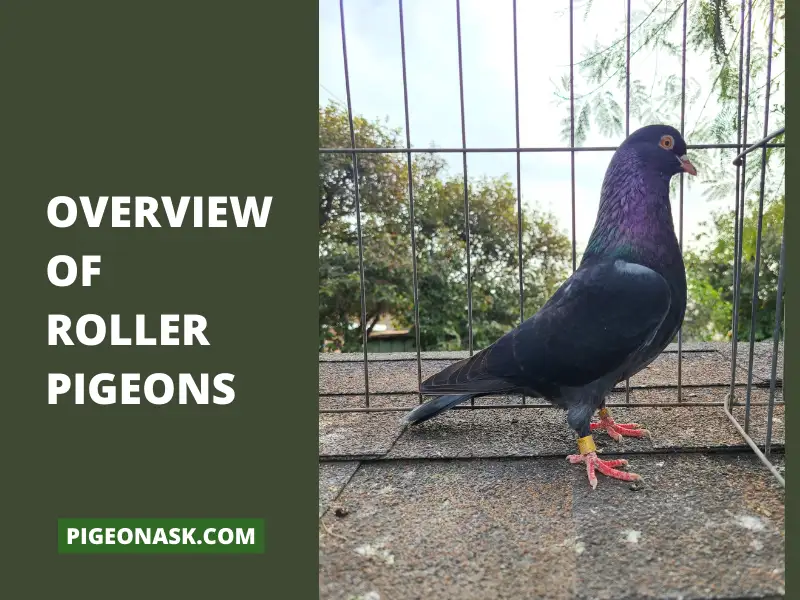
In the world of Roller Pigeons, flight patterns vary—from solo acts to group performances. Step into their breeding facilities, where strategic breeding produces these sensational fliers.
And did you know?
You can determine their gender from day one. Some breeders even blend strains for young birds that start rolling at just 3 to 4 months old. Roller Pigeons: a centuries-old legacy of skillful flight and ongoing fascination.
History And Origins of Roller Pigeons
Roller Pigeons, the maestros of aerial acrobatics, boast a history stretching back to ancient civilizations like Persia and India. As early as 1735, these birds were already captivating enthusiasts with their tumbling and rolling skills.
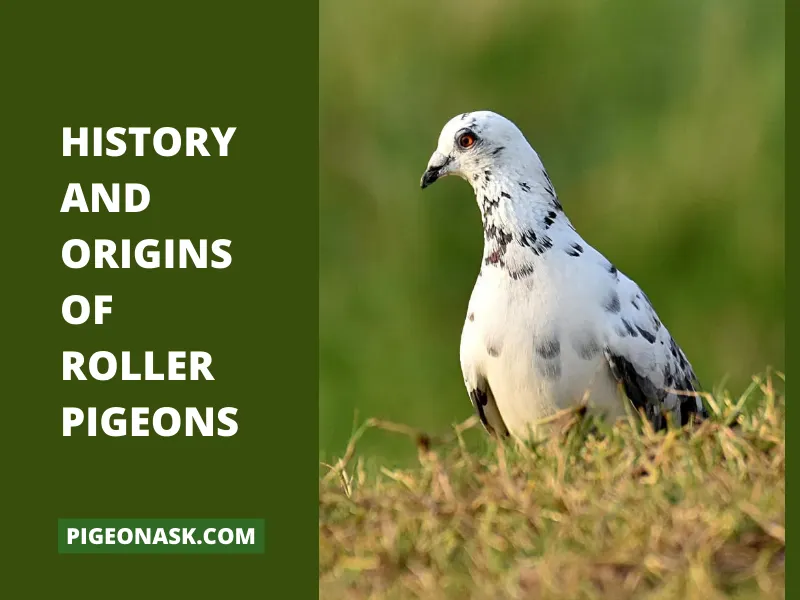
The Oriental Roller, a crossbreed from Persia and England, claims the title of the oldest Roller Pigeon breed. In the mix, we have the Birmingham Roller, a sensation born in England, celebrated for its rapid backward somersaults in flight.
Many believe all Roller Pigeons share roots with the Oriental Roller. This captivating journey through time has given rise to diverse strains like Thor and Dummy, celebrated for their stellar rolling prowess.
Physical Appearance
Roller Pigeons are like the avian acrobats of the sky, boasting features that set them apart in the pigeon realm.
Now, let’s talk plumage – it’s a vivid palette, from classic black and blue-grey to brown, white, and a combo of black and white. Their feathers? Thick, soft, and fashionably close to the body, giving off a casually ruffled vibe.
Wingspread? A cool 24 to 28 inches on average, with a body length dancing between 11 to 15 inches. Moving up, Roller Pigeons sport a petite head, rocking a short and stout beak.
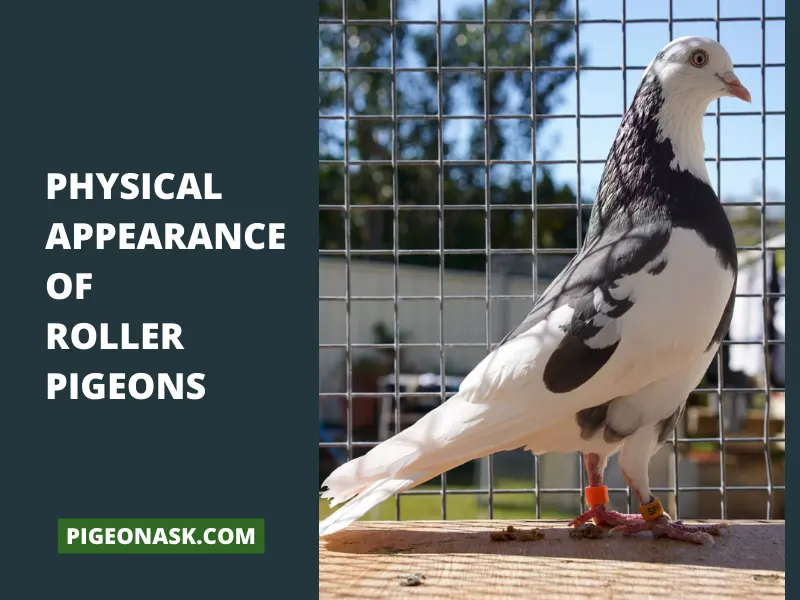
The eyes – oh, the eyes! Oranges, yellows, or reds, encircled by a chic pale ring, all housed in bare skin, adding to their unique charm. Now, the pièce de résistance: their tumbling flight.
A genetic quirk that’s still puzzling researchers, it’s a head-back, tail-up spectacle that defies the norms of pigeon aerial antics.
These pigeons aren’t just birds; they’re an airborne ballet of colors and quirks. A testament to centuries of selective breeding, Roller Pigeons redefine the art of flight.
At a glance –
| Physical Feature | Description |
|---|---|
| Height | 25cm-30cm |
| Weight | Typically between 300-400 grams |
| Size | Small to medium-sized birds with a wingspan ranging from 24 to 28 inches and a body length between 11 to 15 inches |
| Head | Small head with a short neck 2. |
| Bill | Short, stout beak |
| Eyes | Iris can be orange, yellow, or red, surrounded by a pale inner ring. Eyelids are orange, enclosed in a white-grey eye ring. The skin around the eyes is bare |
| Colors | Various colors, including black, blue-grey, brown, white, and white and black |
| Personality Traits | Bold and aggressive |
| Purposes | Bred and trained for competitions, shows, and as pets |
| Lifespan | Can live up to 10-15 years |
Different Strains And Unique Features
01. Birmingham Roller Pigeon
The Birmingham Roller Pigeon, hailing from the streets of Birmingham, England, is no ordinary bird—it’s a sensational performer in the sky.
Picture this: a feathered virtuoso executing rapid backward somersaults mid-flight, an airborne spectacle that has enthusiasts and breeders captivated.
With origins rooted in Birmingham, this breed is no stranger to the spotlight, having been selectively bred for its mesmerizing aerial displays.
Boasting a dual identity, there’s the flying type for those who appreciate a dazzling airshow and the show type, meticulously bred for exhibition glam.
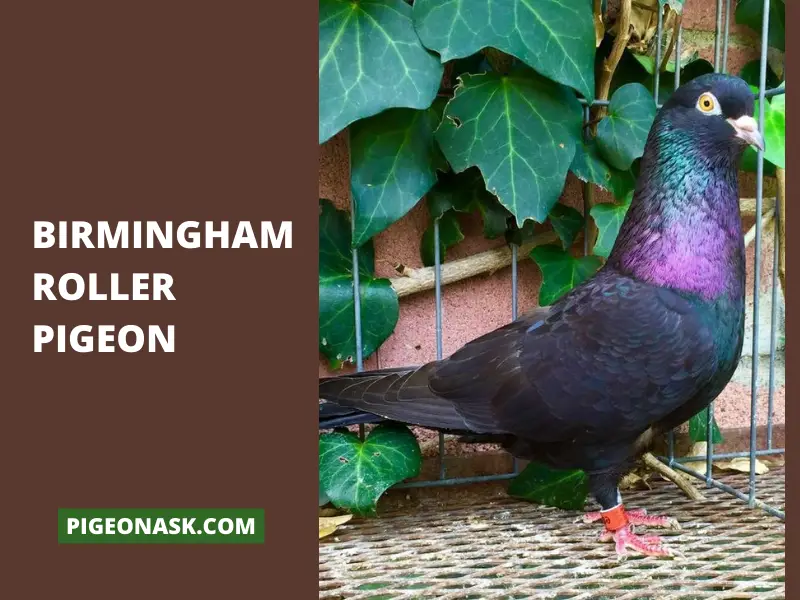
What adds to the allure is the pigeon’s wardrobe – a vibrant palette featuring blue, red, checked, self, bar, spread, badge, mottle, grizzle, and bald patterns. It’s a fashion parade in the pigeon world!
Fueling its fascination, the National Birmingham Roller Club takes center stage, a non-profit on a mission to champion the flying and breeding of these airborne maestros.
But what remains a puzzle is the neurological wizardry behind the enigmatic backward rolls—nature’s secret that keeps us all guessing.
Picture the scene: a competition where these avian acrobats are not just judged but applauded for synchronized rolls, depth, quality, and their knack for group performances, aka “kitting.”
The ideal Birmingham Roller starts its roll sharply, spins like a pro, and does it all with an unbroken finesse.
02. Galatz Roller Pigeon
Enter the enchanting world of the Galatz Roller pigeon, a feathered maestro of the Romanian skies, where each flight is a breathtaking display of aerial artistry.
This domesticated marvel is renowned for its spectacular midair antics – think back somersaults, pirouettes, and gravity-defying rolls that’ll leave you in avian awe.
Hailing from Galați County, Romania, this breed has carved its place in the hearts of pigeon enthusiasts across Europe.
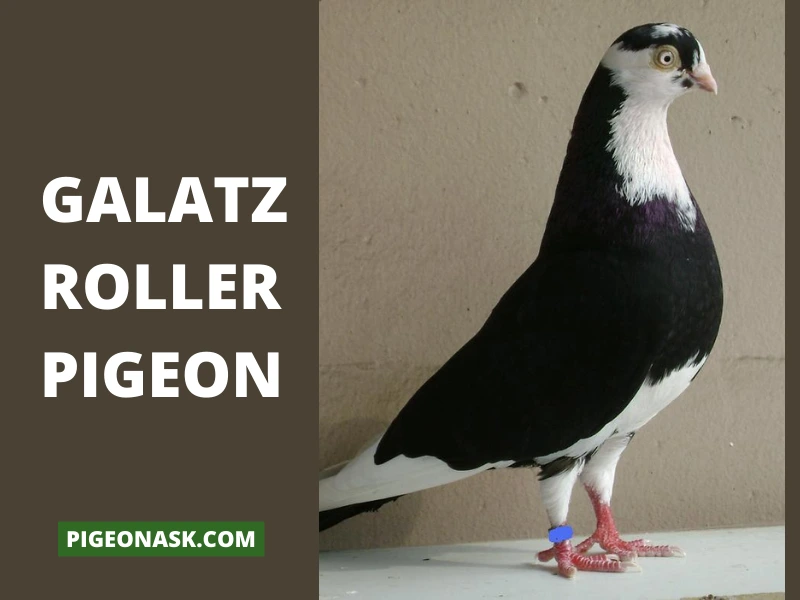
Picture a compact, small-sized charmer with a round breast, short neck, and dainty legs, showcasing an array of colors from white and black to fiery red and diluted blue bar white-flight-pied. It’s a feathered fashion show-up in the clouds!
What makes the Galatz Roller truly unique is its ability to outshine its peers in the roller world.
This high-flying virtuoso, available in both plain-headed and shield-crested variations, boasts a clean-legged or small-muffed style, setting it apart from the pigeon crowd.
Here’s the real showstopper: the acrobatic prowess passed down through generations.
Young Galatz Rollers start with pirouettes, graduate to tail-riding, and master successive somersaults, turning each flight into a mesmerizing performance. It’s like ballet in the skies!
Beyond the glamour, these birds are not just performers; they are hardy and robust, making them the pilots of choice for enthusiasts who appreciate both style and strength.
So, if you’re looking for a pint-sized avian acrobat that brings both elegance and strength to the skies, the Galatz Roller pigeon is your ticket to the ultimate aerial spectacle.
03. Oriental Roller
Oriental Roller is a fancy pigeon breed that’s as unique as it is visually stunning.
Picture this: a feathered virtuoso with a long, high tail boasting 14 to 18 meticulously arranged feathers, creating a mesmerizing display during flight – a true aerial artist in action.
What sets the Oriental Roller apart is its nervous darting motion in flight, adding a touch of performance art to its repertoire.
Adorned in patterned plumage with a kite or bronze coloring, this breed introduces a dilution factor for silver, yellow, and buff hues, making it a living palette in the sky.
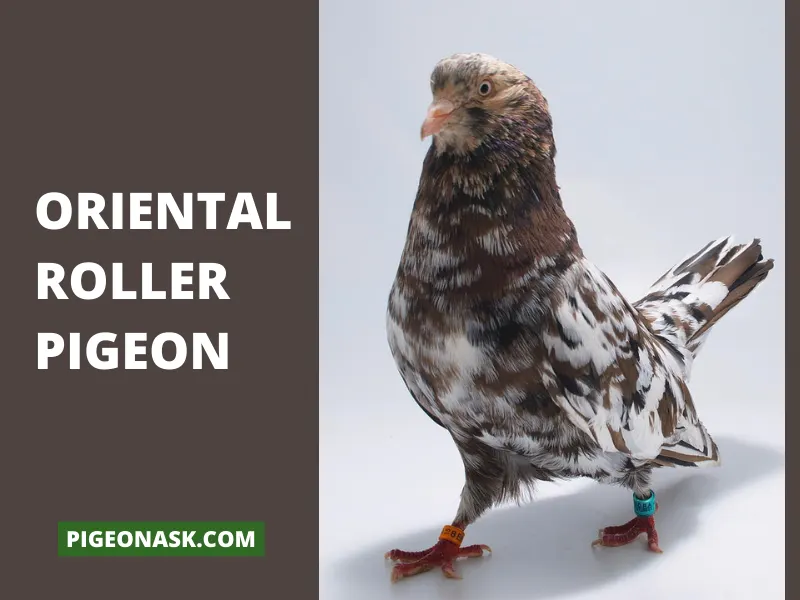
But here’s the kicker – the Oriental Roller comes with a quirk. It’s the only pigeon without an oil gland, further solidifying its status as a one-of-a-kind avian wonder.
In flight, its long feathers and wings carried gracefully below the tail showcase its exceptional flying abilities.
Slightly larger than its Birmingham counterpart, the Oriental Roller sports an oval-shaped head, flat on top, adding to its distinctive appearance.
With a history dating back centuries, this breed continues to enchant pigeon enthusiasts worldwide, proving that in the avian kingdom, the Oriental Roller reigns supreme.
04. Parlor Roller Pigeon
These unique birds, originating from 19th-century Scotland, have a distinctive trait – they lose their ability to fly as they mature.
Instead of soaring through the skies, they captivate audiences with ground-rolling performances, executing somersaults on the earth below.
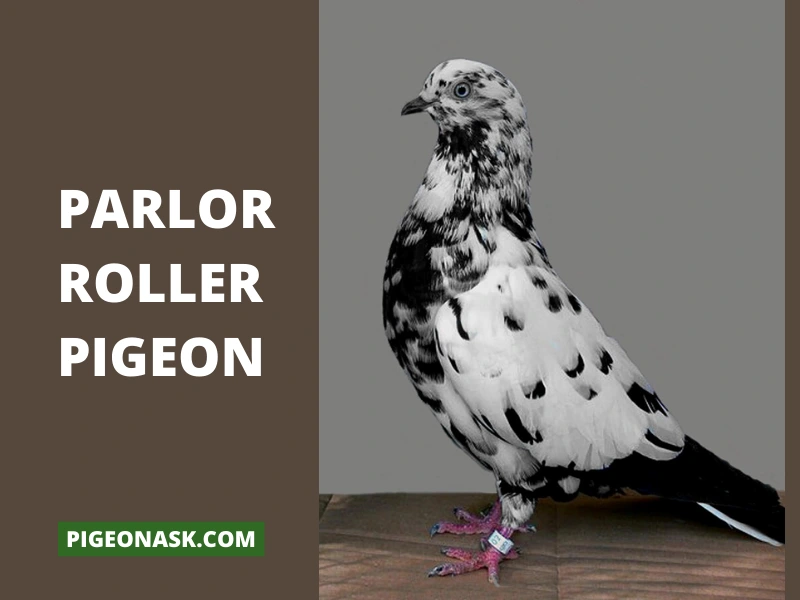
What sets them apart is their exclusive judging criterion; it’s not about appearances but the sheer distance they roll on the ground during competitions.
Despite their inability to take flight, Parlor Rollers find themselves classified in the Flying/Sporting group, a testament to their exceptional ground-based acrobatics.
With a palette of colors and an average weight of 7 to 10 ounces, these non-fliers continue to roll their way into the hearts of pigeon enthusiasts worldwide.
05. Ruby Roller Pigeon
Picture this: a performance that’s not just about flight but a mesmerizing display of rolling ability, velocity, depth, control, and type. It’s like watching a ballet in the clouds, where each bird is a maestro in the art of controlled motion.
What sets the Ruby Roller Pigeons apart? Their consistent and impressive performance in competitions is no accident.
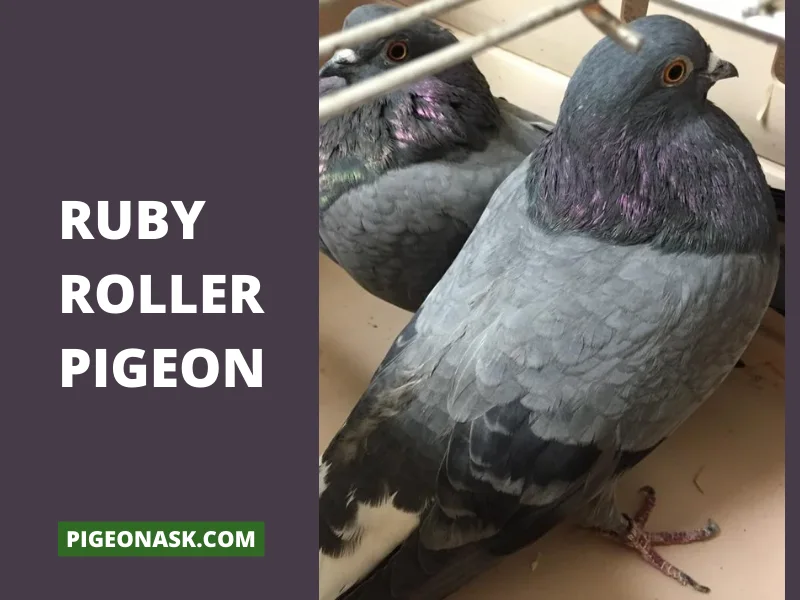
They’re not just fast flyers; they’re masters of depth, maintaining their rolling motion effortlessly. It’s a symphony of control, making them formidable opponents in the air.
But here’s the secret sauce – the Ruby Roller strain is more than just a breed; it’s a legacy. Bred from competition-winning stock, these pigeons are a solid family, ensuring a top-notch performance every time they grace the skies.
Whether you’re a breeder seeking excellence or an enthusiast craving an avian spectacle, the Ruby Roller Pigeons are your front-row ticket to the extraordinary.
Rolling Features
Here is a table with the unique features of various Roller Pigeon breeds –
| Breed | Unique Features |
|---|---|
| Birmingham Roller | Rapid backward somersaults in flight, popularized in Birmingham, England |
| Galatz Roller | Similar tumbling flight to Birmingham Roller, originated in Romania |
| Oriental Roller | No oil gland, more than twelve tail feathers, tumbling flight |
| Parlor Roller | Ability to perform backward somersaults while on the ground |
| Ruby Roller | Five primary traits: depth, speed, frequency, duration, and style |
That’s not all, according to experts the rolling of the pigeons is divided into 5 unique styles, have a look.
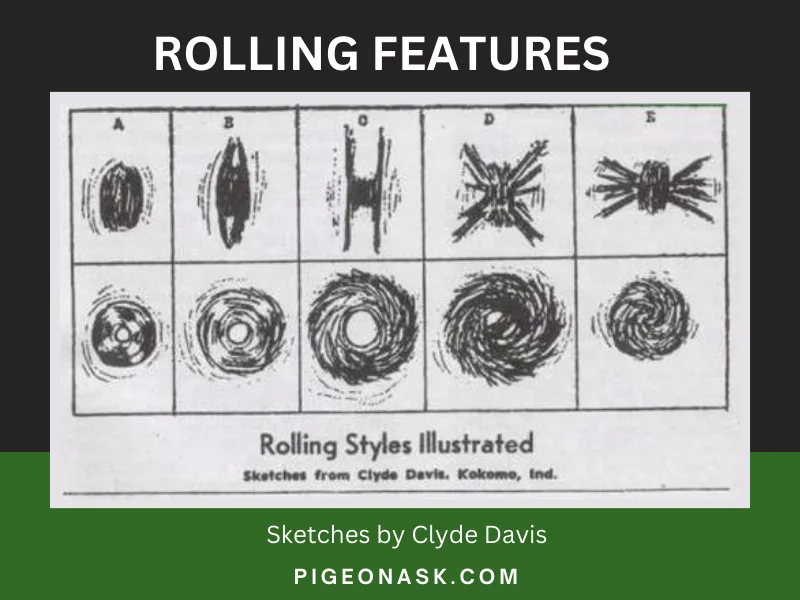
Sketches by Clyde Davis
Here’s a simple table summarizing the main differences in rolling styles based on the provided content –
| Frame | Description | Key Characteristics |
|---|---|---|
| A | Small ball, high-velocity | Tiny hole, rapid descent, transparent wing tips |
| B | Slightly slower than A | Slightly more wing action than A |
| C | Larger ball, prominent hole | About 2-inch hole, front view resembles letter “H” |
| D | Common, often deep rollers | Variable depth, wings at 45-degree angle, “X” shape from front view |
| E | Spinner type, Tumbler style | Small ball, stretched wings, dominant drag in descent |
Color Variations of Roller Pigeons
Understanding their genetics is like deciphering a complex code, where multiple genes and factors play a role in the avian kaleidoscope.
The National Birmingham Roller Club serves as your guide through this avian palette, showcasing patterns like the barless roller with its colored wings and tail feathers or the classic blue bar pigeon with its dark wings and tail band.
Roller pigeon color genetics is a fascinating interplay of spread, recessive red, grizzle, dilute, pied, and bald head genes.
The Practical Rollerman simplifies this genetic tapestry, revealing the three foundational colors of ash/red, black, and brown.
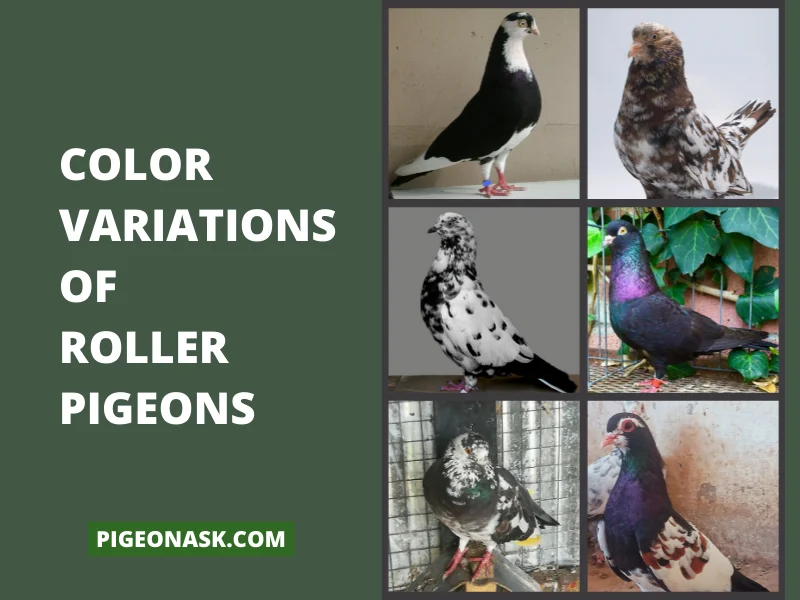
Ever wondered why blue and black are twins or how red emerges from ash-red with a dominant spread gene? The secrets lie in the genes.
Modifiers like spread, dilute, recessive, and patterns dance with these basic colors, creating a spectrum as diverse as the pigeon sky. Whether it’s the fading touch of dilute genes or the vibrant hues of recessive reds, each feather tells a genetic tale.
In essence, roller pigeons are not just aerial acrobats; they’re living canvases painted with the brushstrokes of genetic artistry. The sky is their canvas, and the colors are endless.
Here’s a table summarizing the color and pattern information for Roller Pigeons –
| Aspect | Details |
|---|---|
| Basic Colors | Blue, Black, Red |
| Patterns | T-check/Velvet, Check, Bar, Barless (in order of dominance) |
| Modifiers | Recessive red (brick red color), Dilute (lightens feather color) |
| Breeding for Markings | Not recommended, can lead to undesirable results |
| Common Colors | Blue, Black, Red, White, Brown |
| Common Markings | Bars, Checks, Mottles |
*Breeding for markings is discouraged as it may result in a low ratio of desirable birds. Roller Pigeon appearance can be modified by various genes.
Distribution And Habitat
Roller pigeons have a near worldwide distribution, being present on every continent except Antarctica. They are found in most regions of North America, South America, Africa, Asia, Australia and Europe.
In North America, the highest concentrations of roller pigeons are found in the United States, especially in the states of Texas, Ohio, Kentucky, South Carolina and Georgia. These areas have long-established breeding populations and pedigrees.
In Europe, the densest populations exist in Spain, France, Germany, Belgium and England. Birmingham, England is the origin of the popular Birmingham Roller breed.
Current estimates put the European population at 17-28 million, making it the continent with the largest number of roller pigeons.
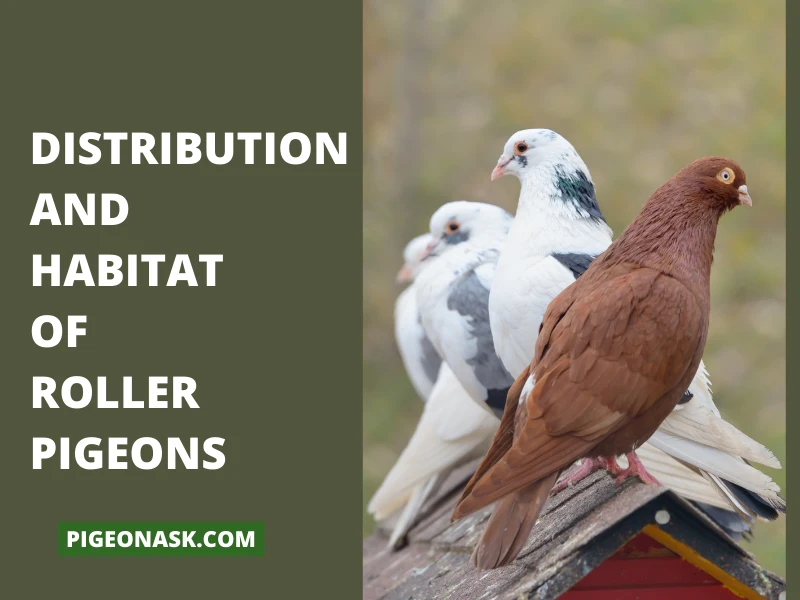
Roller pigeons are also native to the Middle East, tracing their origins to ancient Persia and India.
Contemporary Middle Eastern and Asian countries like Iran, Pakistan, and Japan maintain robust roller pigeon populations and breeding traditions.
Roller pigeons have been introduced to other regions like Africa, South America, and Australia through human migration and pigeon fancying activities. Feral populations now exist worldwide in urban and suburban environments.
However, Antarctica remains unsuitable given its extreme climate. While exact statistical rankings are difficult to determine, the overall geographical distribution correlates to the historical propagation of roller pigeons from their native Middle East/Asia to Europe, then to the Americas and Oceania via human transit.
Their adaptability has enabled feral roller pigeon populations to thrive in diverse urban habitats globally.
Habitat Preferences
Roller pigeons are highly adaptable to diverse environments, both natural and human-made. They thrive in close proximity to human settlements, including urban centers, suburban neighborhoods, farms, and rural areas.
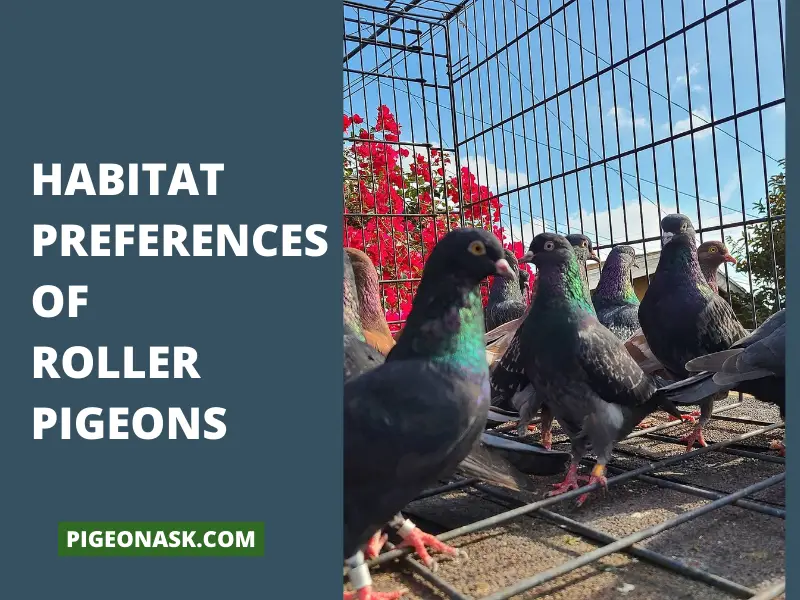
Access to man-made structures and food sources seem to be the key requirements.
Specific types of preferred habitats include –
- Cities – Alleys, parks, buildings for roosting and nesting
- Suburban areas – Residential spaces with access to food waste
- Farms – Barns grain stores provide shelter and food
- Rural areas – Villages, agricultural lands, ranches
- Coastal areas – Cliffs shorelines in their native range
- Mountains/gorges – Native rugged landscapes for shelter
Though adaptable, some ideal conditions in a controlled environment include:
- Spacious aviaries or lofts
- Plenty of perches, boxes for roosting and nesting
- Good ventilation, hygiene, lack of overcrowding
By being flexible in utilizing both natural and human-modified habitats, feral roller pigeon populations have achieved an almost worldwide distribution.
Their dependence on scavenging food waste and crumbs from human activity strongly influences their habitat preferences.
Migration and Seasonal Movements
When it comes to the migratory habits of our feathered friends, roller pigeons, these globetrotting birds certainly rack up their frequent flyer miles!
Unfortunately, the details of their seasonal sojourns remain a bit mysterious since rollers aren’t as well-studied as other avian species. But here’s what we know about the migratory itineraries of these captivating creatures:
While their precise migration routes aren’t mapped out, populations in Europe and Asia are likely to journey to warmer southern regions when winter rolls around.
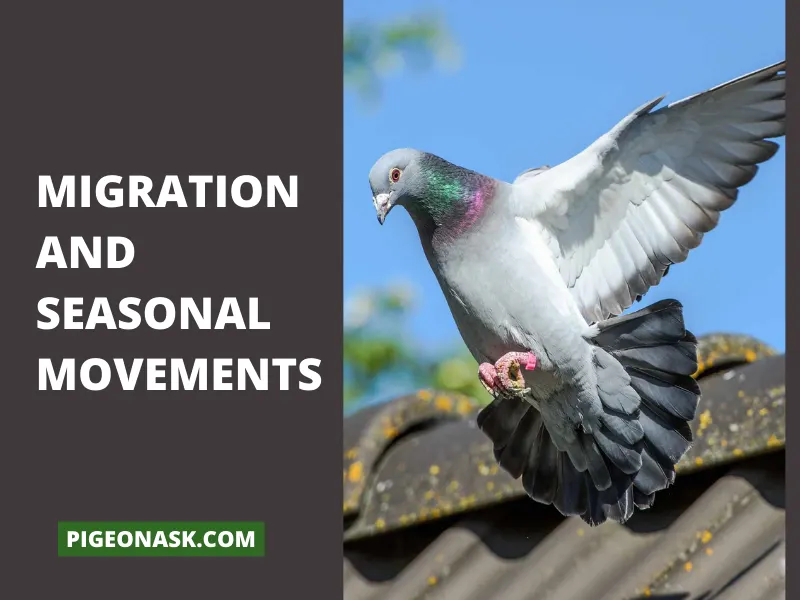
And during these long hauls, stopovers to rest and refuel are essential for a smooth trip. No turbulent flights allowed!
Some savvy rollers in seasonal dry spots wisely make local moves when resources run low. And we can’t forget their legendary inner GPS guiding them back home time and time again. After all, homing abilities are in their blood!
But intriguing questions remain on their migratory strategies and winter lodgings.
Do juvenile and adult rollers travel together in flocks or solo? And what scenic spots serve as their seasonal pit stops?
As devoted scholars of these graceful gliders, unraveling the details of their migration patterns remains an open and exciting frontier!
While roller migration still holds some mysteries, one thing’s for certain – these champion voyagers travel far and wide between their summer and winter homes each year.
Hopefully, future research will further illuminate the migratory world tours of roller pigeons across continents. But for now, we can admire their navigation skills, guiding them through seasonal journeys near and far in pursuit of fair skies!
Threats Status
Here is a fact-based overview of the major threats and conservation status facing roller pigeons –
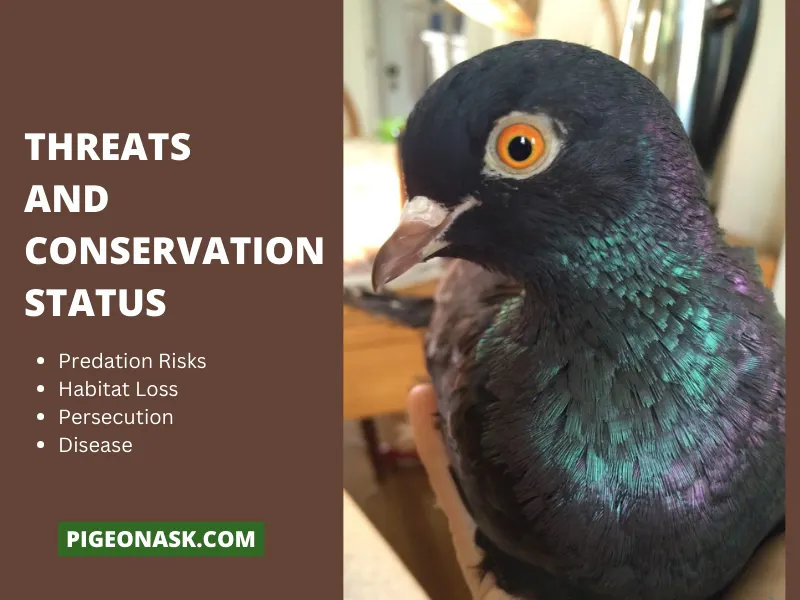
Predation Risks
- Raptors like peregrines and sparrowhawks are the primary natural predators of pigeons, posing risks, especially to racing/homing pigeons during flight.
- Other predators include cats, rats, foxes that threaten nesting sites and squabs.
Habitat Loss
- Urbanization and changing land use reduce suitable habitats and nesting sites.
- Climate change impacts like wildfires also diminish habitat availability.
Persecution
- Some illegal raptor persecution by pigeon fanciers has been reported.
- Use of poisons, nest destruction to eliminate competing raptor populations.
Disease
- Dense populations in urban areas lead to higher disease transmission risks from parasitic infections.
- Respiratory illnesses are a major cause of mortality.
Conservation Status
The European roller flock tallies up to 28 million. But their global numbers soar even higher, thanks to the ubiquitous feral pigeon whose legions exceed 500 million worldwide.
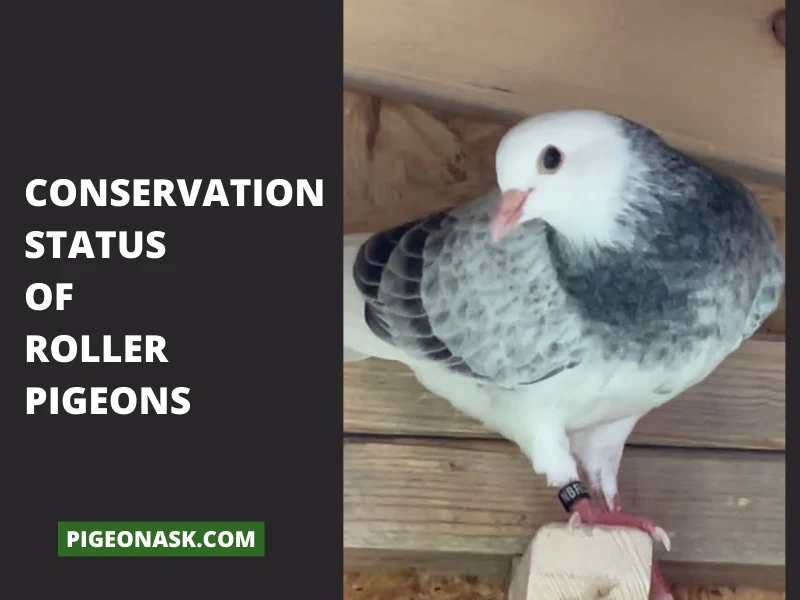
Though an exact count evades us, these figures reveal Roller Pigeons collectively constitute an abundant avian clan. While not endangered, maintaining genetic diversity remains vital for these pigeon populations traversing the planet.
- Domesticated roller pigeons are not considered threatened as a species, given the large global populations.
- No special conservation designations exist due to their abundance as a feral/domesticated population.
- Conservation efforts focus more on threatened wild pigeon species.
Roller pigeons face diverse threats from predation, habitat loss, persecution, and disease risks requiring mitigation.
But as a whole, roller pigeons are not an endangered population warranting focused conservation efforts. Maintaining breed diversity and habitat availability is important for their continued success.
Behavior And Traits
Let me walk you through some of the most fascinating behaviors and traits of our acrobatic avian friends – the remarkable roller pigeons.
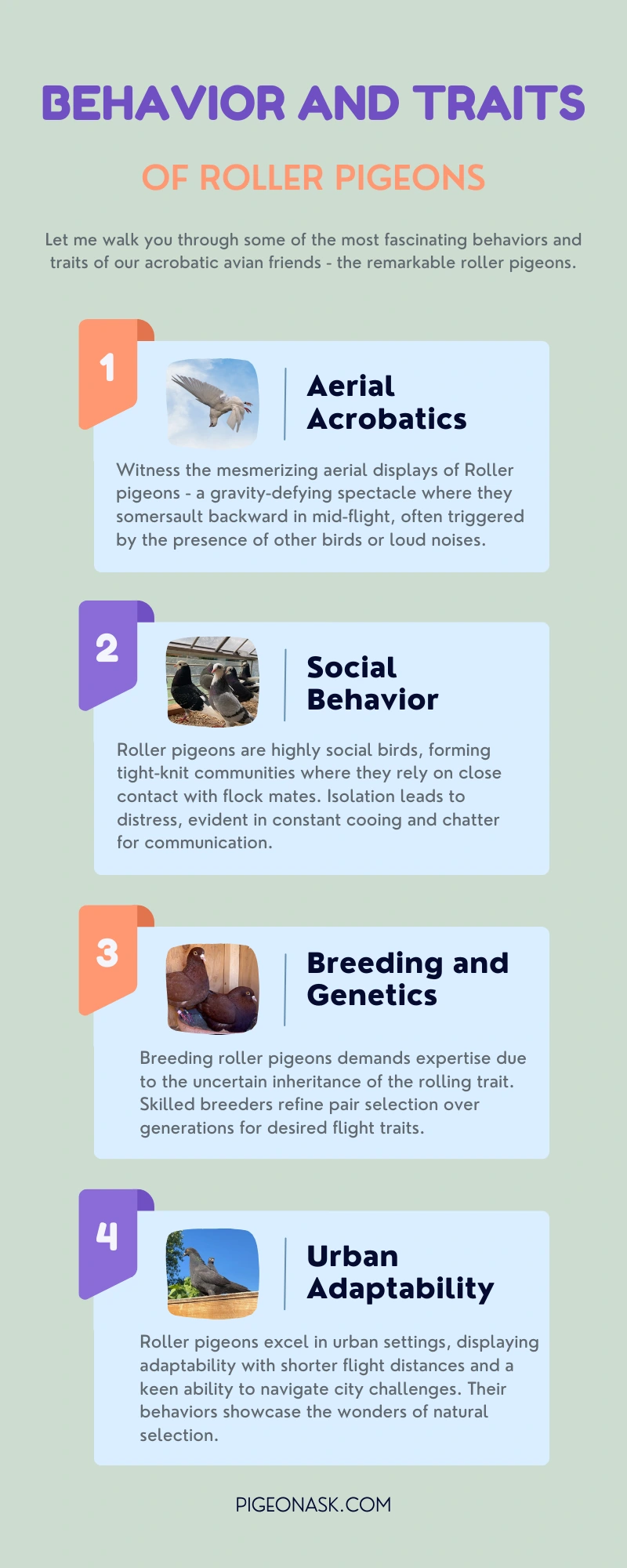
Aerial Acrobatics
First, their gravity-defying aerial shows simply must be seen to be believed. With ease and grace, rollers somersault backward in mid-flight, putting on a true airborne ballet.
This rolling technique seems to be triggered by the presence of other birds or sudden loud noises, almost like the pigeon version of showing off!
Social Behavior
Roller pigeons are also incredibly social creatures. They form deeply bonded communities and really rely on close contact with their flock mates.
Isolate a roller pigeon, and you’ll quickly see signs of distress at separation from their tight-knit crew. It’s no wonder they coo and chatter constantly to communicate within their social circle.
Breeding and Genetics
Now, breeding these birds takes knowledge and care because not all offspring inherit the coveted rolling ability through genetics.
By understanding how the rolling trait is passed on, expert breeders can better select pairing and produce flocks featuring smooth backward tumbling flight. It’s a fine art honed over many generations!
Urban Adaptability
Don’t underestimate the city survival skills of roller pigeons! Having adapted beautifully to urban landscapes, they display behaviors like shorter flight distances from humans and an uncanny knack for navigating the hazards of the concrete jungle.
If pigeons went to school, rollers would ace urban studies every time!
From their spine-tingling aerial maneuvers to their strong social bonds and city savvy, roller pigeons continue to fascinate and delight all who encounter them.
Their unique traits and behaviors are a testament to the wonders of natural selection and the capabilities of our avian friends.
Personality Traits
Roller Pigeons, beyond their mesmerizing aerial displays, exhibit a spectrum of intriguing personality traits that add depth to their avian charm. Let’s delve into the fascinating world of Roller Pigeon personalities:
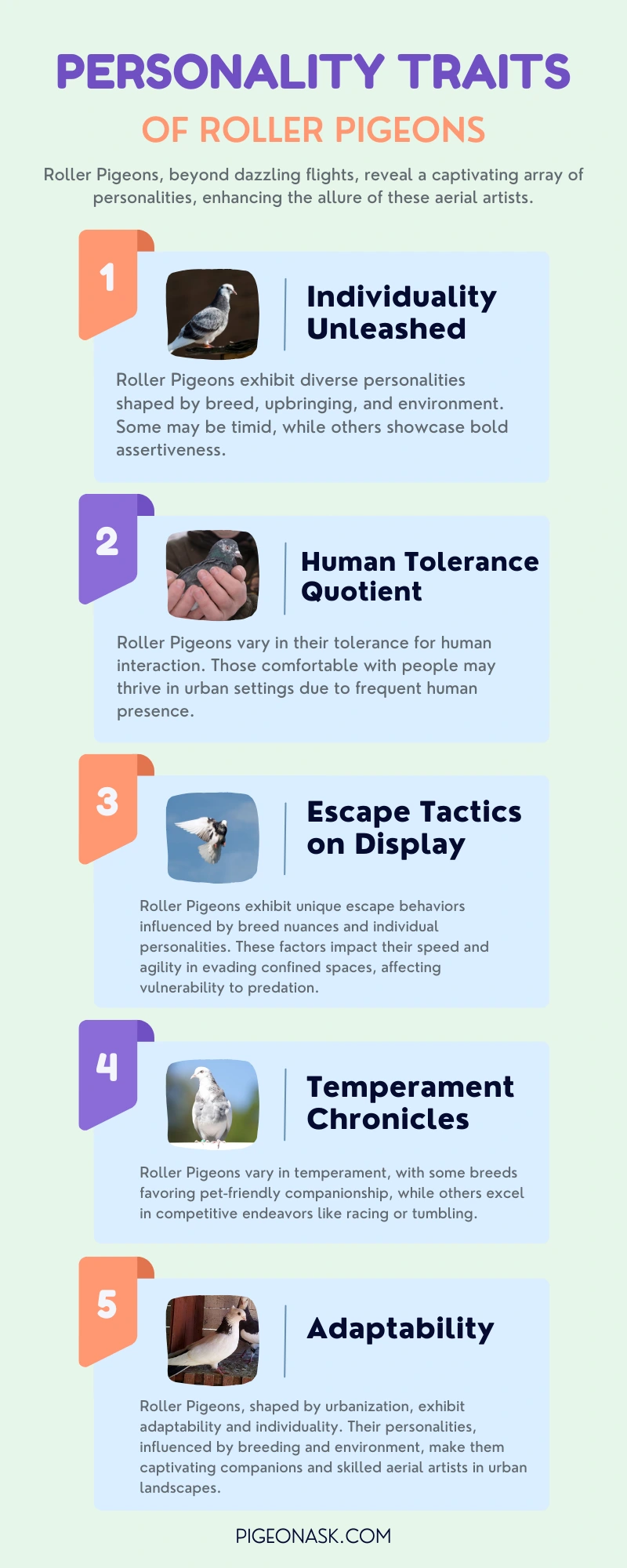
Individuality Unleashed
Each Roller Pigeon boasts an exclusive personality canvas, painted by the strokes of its breed, upbringing, and environment. Some may shy away in timidity, while others boldly flaunt a more assertive demeanor.
Human Tolerance Quotient
Like us, these birds showcase diverse levels of tolerance to human interaction. Those embracing a friendly rapport with humans might find urban environments more accommodating, given the frequent human presence.
Escape Tactics on Display
Watch closely, and you’ll observe distinct escape behaviors among Roller Pigeons. Factors like breed nuances and individual personality influence their speed and agility in evading confined spaces, impacting their vulnerability to predation.
Temperament Chronicles
While painting Roller Pigeons with a broad temperament brush is challenging, certain breeds exhibit characteristics that align with pet-friendly companionship or participation in competitive endeavors, such as racing or tumbling.
Adaptability
Roller Pigeons have mastered the art of thriving in urban jungles. Influenced by human activities and urbanization, their adaptability shines in cities, suburbs, and other human-inhabited spaces.
Their personalities, shaped by breeding, upbringing, and environment, weave a tale of individuality, adaptability, and intriguing behaviors that make them not just skilled aerial artists but captivating companions in our urban landscapes.
Breeding And Maintenance
Breeding Roller Pigeons is a nuanced endeavor that demands careful consideration of various factors. Here’s a step-by-step guide to navigating this fascinating journey –
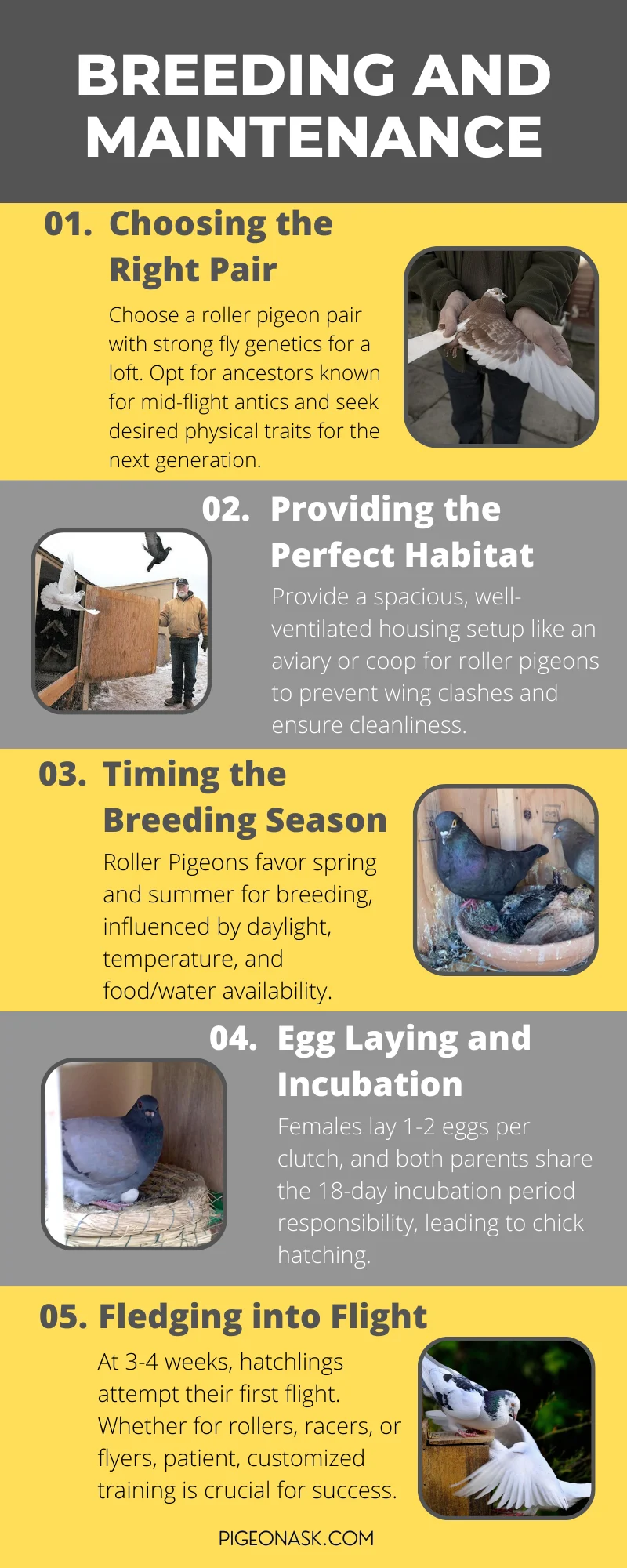
01. Choosing the Right Pair
Choosing the right roller pigeon pair to start a loft is clutch. Look for a cock and hen with fly genetics – a pedigree with plenty of ancestors known for nose-diving antics mid-flight.
An ideal couple boasts the coveted physical traits you’re aiming to pass on to the squeakers.
02. Providing the Perfect Habitat
House your birds in a chill crib, like an aviary or a decked-out coop. Roller pigeons need room to spread their wings without ruffling feathers against other birds. Ventilation and cleanliness are key for these flyers too.
03. Timing the Breeding Season
Roller Pigeons prefer the spring and summer months for breeding. The onset of the breeding season hinges on factors such as daylight hours, temperature, and the availability of adequate food and water.
04. Egg Laying and Incubation
The female will lay one or two eggs per clutch, with both parents sharing the responsibility of incubation. And the incubation period spans approximately 18 days, culminating in the hatching of the chicks.
05. Fledging into Flight
Soon, the hatchlings will try their maiden flight, showing you their aerial skills as early as 3-4 weeks old. Then the real training begins – whether you want to coach your flock for rollers, racers or flyers.
Patience and a customized approach are clutch since each bird learns at its own pace. It’s a long but worthwhile journey to breeding champs from chicks.
Maintenance Recommendations
Maintaining Roller Pigeons involves several key steps and considerations. Here is a guide on how to maintain Roller Pigeons –
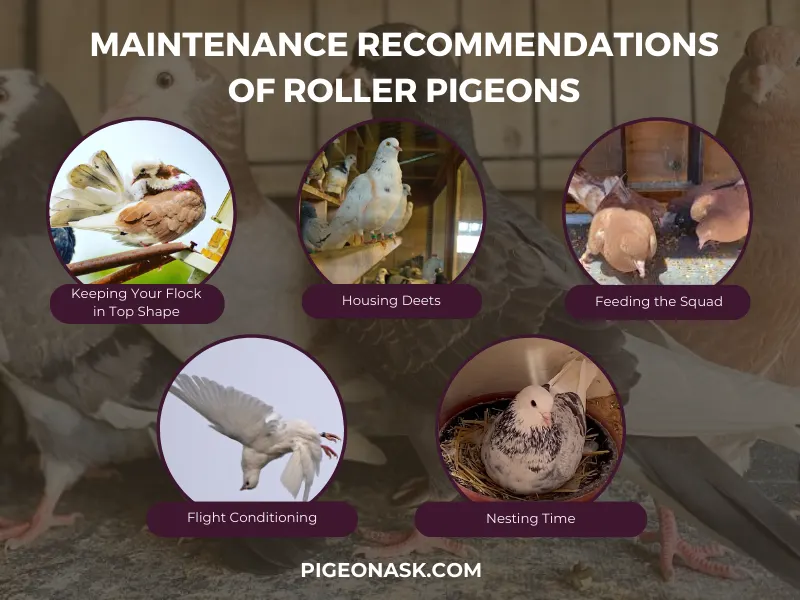
Keeping Your Flock in Top Shape
When it comes to caring for your feathered rollers, cleanliness is clutch. Scoop out all the bird bombs, spilled grub and shed plumage from the crib regularly.
Watch for any mouse droppings too – gotta keep the coop hygienic to avoid the spread of illness.
Housing Deets
Roller pigeons need roomy digs like an aviary or a decked-out coop with ample spots to perch. Ventilation and sunshine are key too – a bright, breezy crib keeps the flock healthy. Don’t forget comfy nesting boxes for breeding pairs to do their thing.
Feeding the Squad
Good grub is essential to keep your rollers rolling. Feed a balanced mix of grains, seeds and at least 15% protein. During the breeding season, up that protein amount.
Don’t forget the grit – it helps birds process their food. Providing clean water daily is a must too.
Flight Conditioning
Ease young rollers into flight training through gentle conditioning. Patience is key since each bird learns at its own pace.
Start by getting them used to equipment like harnesses before introducing basic commands. Short, frequent sessions are best as they build up wing muscle and stamina.
Nesting Time
Give breeding pairs nesting bowls or boxes with enough room to avoid kicked-out eggs. Ceramic, wood or plastic containers work well. Position them thoughtfully in the coop so both parents can access the nest.
Having backup nests on hand helps avoid squabbles during prime breeding season.
Stay on top of the cleaning, housing, feeding, training and nesting needs of your roller flock. Following these crucial steps will keep your pigeons primed for those spectacular midair spins.
Final Words
From the skies of ancient Persia to the urban jungles of today, roller pigeons have dazzled humankind with their aerial acrobatics and remarkable talents. Their gravity-defying backward somersaulting remains an enduring fascination.
Beyond the spectacle of flight, rollers reveal sophisticated behaviors, personalities, and adaptability that have enabled their success alongside humans across changing landscapes worldwide.
The diversity of breeds, each with its own flair, provides insight into avian evolution shaped by selective breeding. Roller pigeons embody wonders of both natural selection and domestication.
If you have enjoyed this, why not subscribe to our social handles, we are available on Twitter, Facebook and Google News.
References
- https://www.ncbi.nlm.nih.gov/pmc/articles/PMC4614540/
- https://nbrc.us/home-page/the-basics/1615-2/
- https://nbrc.us/home-page/birmingham-roller-origins/
